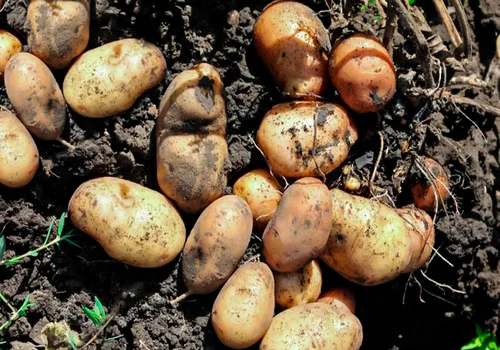Potatoes are one of the most versatile and widely cultivated crops around the world. Growing potatoes can seem challenging, especially if you’re trying unconventional methods, such as growing them without soil fertilizer. In this article, we’ll explore a unique approach to planting and growing potatoes by using minimal water, relying on rainfall, and avoiding soil fertilizers altogether. This method is perfect for those who want to try an eco-friendly and less resource-intensive way to grow their crops.
Preparing the Soil and Planting Potatoes
The first step in this process is preparing the soil by creating a mound of sand about 80 cm in height. This mound will help ensure that the potatoes have adequate drainage, preventing waterlogging, which is crucial for healthy root development. Once the mound is ready, you can dig small holes and start planting your potato seeds.
Unlike other crops, potatoes are planted with their roots facing upward. After placing the potatoes in the holes, cover them with enough sand so that only about a quarter of the root is exposed. It is preferable to cover them completely, as any exposed roots can lead to drying or sun damage.
Watering and Initial Growth
After planting, it is essential to water the potatoes lightly. This is the only time you will need to water them for the first two weeks. Given that the planting is taking place during the winter months, the potatoes will mainly receive water from rain and the natural dew that forms daily. Within ten days, you should start to see signs of sprouting.
As the potatoes begin to grow, you must regulate the watering process. Be careful not to overwater, as potatoes require minimal moisture. Around two weeks after planting, it’s advisable to apply a foliar spray of a balanced fertilizer (20-20-20) to support the plant’s growth. This process can be repeated weekly, depending on the plants’ development.
Managing the Growth Process
As your potatoes continue to grow, it’s crucial to maintain a regular watering and fertilizing schedule. Potatoes typically show clear signs of growth within three weeks of planting. During this time, you might also want to spray growth regulators like auxins, which encourage healthy growth in both vegetables and fruits.

At this stage, it’s essential to observe the plants closely. When the leaves are small and tightly packed, it can be a sign of excessive sun exposure or insufficient water. Conversely, large, healthy leaves indicate that the plant is thriving and receiving the right amount of water and nutrients.
Potatoes’ Growth Cycle and Harvesting
Potatoes generally take 90 to 120 days to mature. There are two ways to determine when your potatoes are ready for harvest: either wait until the plant starts to yellow and wilt around the 90-day mark, or leave them until the full 120 days if the plant continues to thrive and produce flowers.
It’s important to note that potatoes exposed to sunlight can turn green and become toxic. To prevent this, make sure to cover any exposed parts of the potato with soil, sand, or even leaves to protect them from the sun’s rays.
Final Thoughts on Potato Harvesting
By the end of the three-month growing period, the majority of your plants will have started to die off, indicating it’s time to harvest. Simply dig up the soil and pull out the potatoes. On average, you can expect around 6 kg of potatoes from 16 planted seeds. This result is quite satisfactory, though you can aim for even larger yields in future harvests by experimenting with compost or different fertilization techniques.
In conclusion, this method of growing potatoes without soil fertilizer is ideal for those who want to reduce their environmental impact or have limited resources. The process is simple, and with careful attention, you can achieve healthy, thriving crops.




